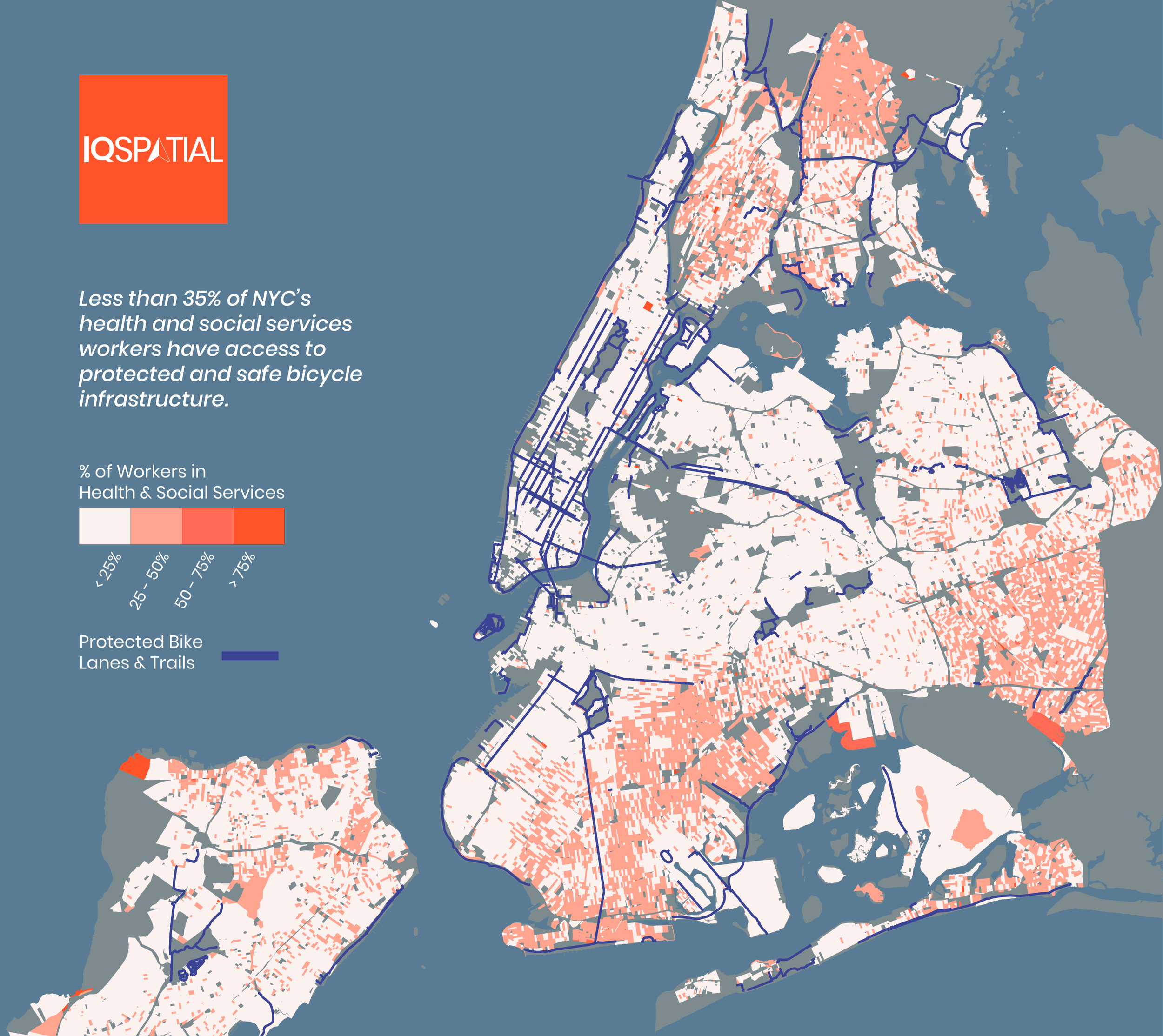Essential workers’ bike access limited during COVID-19 crisis
By Alyssa Pichardo and Jose Pillich, PhD
Another bike boom is on the rise in North America as the bicycle serves the most essential needs to get around during the coronavirus crisis - affordable and socially-distanced transportation. And while bikeshare stations are packed near hospitals - essential workers, who are predominantly women and people of color, still have less access to safe cycling.
Bike commuting on protected lanes that cut the risk of injury due to collisions by 20% and help riders maintain social distancing, is not an option for most essential workers. In this analysis, essential workers are those working in the health and social services sector. Fewer than 35% of NYC’s essential workers have access to safe biking infrastructure and only a third of hospitals and medical facilities are safely accessible by bike.
Why it Matters: A safe bicycle commute can slash workers’ commuting expenses dramatically. With packed buses and unsafe crowding conditions for public transit, there is potential to improve essential workers’ health and limit their coronavirus exposure with a bike commute on protected lanes and trails.
Safe protected bicycle infrastructure, within less than a quarter-mile, is available to less than 35% of NYC’s essential workers. Fewer still have access to bikeshare, only 18%.
Map of Essential Workers Home Locations and Protected Bike Lanes & Trails in NYC
Essential workers are predominantly women and people of color.
Over 75% of NYC’s social and health workforce is women.
And 54% of social and health services workers are minorities.
The vast majority of the essential workforce lives in minority communities in the Bronx, Queens, and south Brooklyn and they are earning 20% less than their white counterparts. On average NYC’s non-white healthcare and social services workers earn $50,052 annually compared to $62,304 per year for white workers in the same industry. Free and easy access to work by bike should be available to these essential workers and their communities.
Where protected bike lanes are in NYC, reflects systematic racism in how infrastructure is built in cities and does not provide equitable cycling access for essential workers. Since 2000, NYC’s community districts that are predominantly white and wealthy have seen public investment in protected bike lanes. Only 14 of the City’s 59 community districts have more than 3 lane miles of protected bike infrastructure, be it protected lanes or off-street trails. Half of these fourteen community districts are more than 60% white with average household incomes greater than $172,000. Of the City’s 117 miles of protected bike lanes and trails, 25 miles are within these wealthier and whiter community districts.
Interactive of Protected Bike Lane Miles Built in NYC Community Districts since 2000
Short-term solutions in recent months have sought to get NYC’s essential workers access to bikes. Motivate/Lyft recently donated 30 bicycles to workers of the hard-hit Elmhurst Hospital in Queens. And non-profit organizations like Transportation Alternatives are providing free bicycles to essential workers during this time, but having access to a bicycle is only one half of the equation for a safe ride. The other half is building protected bicycle infrastructure.
Bikeshare and protected bike lanes are the most flexible transportation systems that exist. Milan is adding 22 miles of protected bike lanes in three months, installing new lanes in less than 10 days even during national quarantine orders. NYC is adding only 9.2 miles of protected bike lanes this year, but few connections are in Queens and no new protected lanes are being built in the Bronx. Docking stations for Citi Bike can be deployed in a matter of hours and NYC needs to expedite the Citi Bike system expansion to the Bronx and into Queens if there’s any hope of the system serving essential workers. Both city governments and micromobility operators need to create equitable and accessible cycling systems for essential workers and their communities. More equitable expansion of bicycle infrastructure and bikeshare not only serves anti-racism goals but crucially helps essential workers get to work safely and affordably so they can continue to save lives now and in the future.
All data has been sourced from NYCDOT, CitiBike & the US Census Bureau and analyzed by IQSpatial, LLC.

